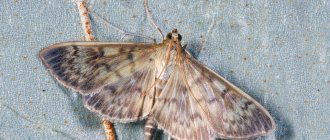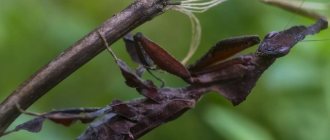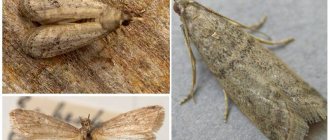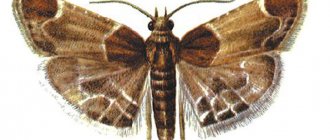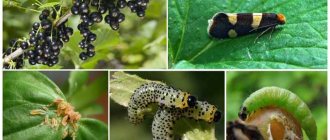Causes of pests on carrots
Most often, the appearance of a certain type of pest depends on the conditions created and suitable only for it.
Generally speaking, the appearance of pests is influenced by the lack of crop rotation. Carrots are planted in the same place for several years in a row. As a result, parasites get used to the fact that this place is safe and there is always something to profit from.
One of the reasons for the appearance of pests may be an unsuccessfully chosen place for a carrot bed. It should not be placed in the shade or separately from the entire garden. It is better not to plant carrots next to coniferous plants.
Another reason for the appearance of pests on carrots may be the use of the same feeding or fertilizer. Or their timely introduction into the soil.
Well, the last reason is unsuitable climatic conditions - extreme heat or cold and dampness. Unfortunately, the gardener cannot influence this in any way. But it can slightly regulate climatic conditions by watering.
What damage does the wireworm cause to carrots?
Wireworms live in the soil, looking for beds with nutritious and fleshy root crops. Having found a suitable object, it literally bites into it, causing mechanical damage to the carrot. The above-ground part of adult plants is rarely affected, and people discover the results of the pest’s activity only during harvesting.
In this case, the plant inevitably suffers, because the larvae extract useful elements and juices from the root crop. As a result, the quantity of carrots harvested decreases, and its quality becomes worse due to damage. Another danger lies in the fact that the affected plants become vulnerable to fungal and bacterial infections, because microorganisms easily penetrate into the root crop through cracks and holes in the carrots. Because of this, putrefactive processes appear that can lead to the death of the plant.
Wireworms pose a particular danger to planted seeds and young carrots. He is capable of completely destroying them.
Click beetle larvae often live in colonies, infecting individual areas of the garden bed. Therefore, one of the signs of damage in young plants is local thinning of plantings.
Carrot pests in the garden and how to combat them photo
carrot fly
The carrot fly is a dangerous and almost invisible pest that can cause great damage to the crop. This fly is very small - no more than 5 mm in length, has an elongated red body and transparent wings. It overwinters in the ground and wakes up when the soil warms up.
The main damage to carrots is caused by its larvae. The fly lays them in the ground, and there they begin to eat everything that comes along the way. It is simply not possible to notice their presence at first, due to the fact that they are underground.
Over time, the tops of infected carrots begin to change color. It turns purple, then withers and dries up. If you dig up a root crop, you can see passages from larvae and transverse black stripes in it.
It is difficult to fight such an enemy. Because even sudden frosts are not scary for a fly. She waits for them in the ground. Methods to combat it are divided into 3 stages:
- prophylactic,
- repellent,
- destroying.
Preventive measures include:
- Selecting seeds that are resistant to the pest. Such as Nantes 4, Olympus, Flakke.
- Planting carrots in sunny areas, not in the shade.
- Timely removal of torn carrot tops from the garden bed. Otherwise, it will attract flies with its smell.
- Adding red and black pepper to the soil when loosening to repel flies.
- During the summer in the middle zone, the fly lays larvae twice a season. Try to keep planting seeds and digging carrots separate from the summer of these two generations. The first takes place from late May to late June, and the second from mid-July to mid-August.
Planting onions or garlic near carrot beds is a deterrent. The fly cannot stand its smell and therefore will not fly up to it.
Or you can pour an infusion containing these ingredients over the carrots. Pour 300 grams of onions with 2 liters of boiling water and leave to steep for a day. Then add 10 liters of water and 30 grams of soap. Spray plants and row spaces with this solution.
You can simply spread onion peels or tobacco between the rows of carrots. We recommend reading about the benefits of onion peels for plants.
Or prepare an infusion of 4 kg of tomato tops and 10 liters of boiling water. Leave the mixture to infuse for 2 days, then add 50 grams of soap to it and spray the garden bed.
An infusion of wormwood helps well: pour boiling water over a bucket of herbs and let it stand for a day. Then divide into 3 parts, strain, and add 8 liters of water to each part. You can spray the beds with this solution, and put the wormwood from the infusion between the rows of carrots.
If traditional methods do not help, then use the following chemicals to kill flies:
- Karate Zeon - 50 grams of the drug is diluted in a bucket of water, you can spray carrots with it once a month.
- Boreas - use 0.2 liters of product per 1 liter of water, at least once a month.
- Vantex - 0.1 liter per 10 liters of water, use at least once a week.
- Tzipi – 0.5 liters of the drug per 10 liters of water. Treatment is carried out at least once a week.
- Arrivo - 0.02 liters of product per 10 liters of water. Treat the plant at least once every 20 days.
- Inta-Vir – 1 tablet per 10 liters of water. Also process at least once every 20 days.
How to protect carrots from rodents in the garden
Everyone knows what mice and rats look like. But few people know why they appear in the garden and how to get rid of them.
In order not to attract them to the garden, try in the fall after harvesting not to leave the remains of root crops in the garden bed; if possible, remove the compost heap.
If, after all, mice visit the garden and spoil the plantings, then plant anise or mint next to the carrot bed, you can lay out sprigs of wormwood. Rodents do not like these aromas and will scare them away from planting.
You can sprinkle the beds with ash; mice don’t like it either. If mice have made a hole in a greenhouse, then some gardeners suggest soaking a cloth in ammonia and sticking the rodents into the holes in order to drive them away.
Mice don't like loud noises, so you can hang empty cans over your garden bed. They will sway in the wind and make unpleasant sounds that will scare away mice.
In addition to the traditional methods of rodent control listed above, there are other methods.
Many summer residents set purchased or homemade traps.
Some people suggest lubricating the inside of the jar with oil to make it slippery. And put bait inside. Place the jar on a bed with carrots, slightly tilting the neck towards the ground so that the mouse can climb inside. But she won’t be able to get out because of the slippery walls.
Or put a plastic bottle on a bucket. Pierce the bottle all the way through with a knitting needle. And put bait inside the bottle. The mouse will follow it, but due to the fact that the bottle is spinning, it will fall into the bucket.
You can use purchased grain baits with poison. Such as Rodefakum, Myshivon, Difakrat. They need to be laid out on the garden bed and around it every 3 meters. But you need to work with gloves.
There are granular baits Varat, Delny Kot, Gratidion, they are also effective. Mice drag them into holes and share them with their relatives.
Another option for controlling mice is Rodenticidal foam. This foam contains poison, but it acts in two directions. It can be spread on the beds like ordinary poison. Or you can foam the cracks gnawed by mice. Even if the rodent does not eat the foam, then, having soiled itself on it, it will be forced to clean its fur.
The most famous drugs from this series: Brodirate, Killer Rats. For the street there are special preparations Norat, Rodent, Mortorat, which do not get wet in the rain and are harmless to birds.
You can use special glue traps. They work very simply - when stepping on them, the mouse gets stuck and cannot move further.
If you feel sorry for killing mice, then you can use electronic and ultrasonic repellers. Acting on the nervous system of rodents, they do not allow mice to approach the garden bed.
If for some reason all these devices do not suit you, get a cat. This is the best protector against rodents.
Wireworm
This little worm lives in the ground and feeds on root vegetables. He makes passages in them and eats the pulp. In this regard, it is difficult, almost impossible, to notice it until the harvest. In addition to eating carrots, spoiled fruits become vulnerable to pathogenic fungi.
To avoid such pests, try to remove all weeds when digging the beds in the fall. Sow mustard and plant it in the garden bed in the spring. Its pungent taste will repel wireworms. We recommend reading: Green manure Mustard: when to sow and when to bury green manure. You can plant legumes, for example, a vetch plant. Legumes should be planted between the rows of carrots; the parasite does not like them either.
You can build bait to catch wireworms. To do this, pin raw potatoes on sticks or wire and hide them in the ground in a carrot bed. Check the bait periodically and destroy any caught parasites. The bait will work more effectively if it is sprayed with chemicals.
If this does not work, then use biological and chemical drugs. For example, Soil Protection is a biological agent that is placed in the soil when sowing seeds. It fights wireworms without harming carrots or humans.
Provotox is not addictive to the parasite and does not kill earthworms.
The most toxic remedy is Bazudin - it is used if nothing else has helped.
There are also different universal insecticides: Aktara, Zemlina. Use them according to the instructions, but if they don’t help, just change the product, the wireworm has probably developed immunity to it.
There are also fertilizers with insecticides. They also feed carrots and kill parasites.
When working with chemicals, follow safety precautions. Carry out work wearing gloves, a respirator and goggles. If the drug gets on the mucous membrane, rinse immediately with water, and be sure to wash your hands after work.
You can also use traditional methods. They are not so effective, but they are safe.
- Pour half a kilo of nettle with a bucket of water and leave for a day. Then strain and water the garden bed.
- Instead of nettle, you can use celandine. You need 100 grams per bucket of water. Leave it for three days.
- An infusion of dandelion roots works well. 200 grams of raw materials are poured into a bucket of water, left for 12 hours and watered over the carrots.
- You can use coltsfoot. Take 20 grams per 10 liters of water. They also leave for 12 hours and water the beds. It should be watered for a month, every 10 days.
These infusions can also be used to water the holes before planting carrots for prevention.
Fighting root-knot nematode
Root-knot nematode - despite its beautiful name, has a very unpresentable appearance. This is a small worm that parasitizes the roots of plants.
It penetrates inside the root and lays its larvae there, as a result of which growths - galls - form on the roots, as soon as they burst, the larvae fall into the ground and everything starts all over again.
In addition to the fact that the worm spoils the plant, it is also a carrier of various diseases, which are difficult for a weakened plant to fight. It is difficult to notice this worm because it parasitizes underground; its presence becomes visible when the carrot tops begin to turn yellow and dry. And getting it out of the garden is even more difficult.
The main part of the recommendations for combating this carrot pest comes down to preventing its occurrence. Because it is much easier to prevent than to defeat. Therefore, be sure to quarantine purchased seedlings for several weeks before transplanting into the ground. Disinfect purchased seeds before planting. Plant more marigolds; the nematode avoids such a neighborhood. Carefully remove plant debris from the ground in the fall and dig the soil deeply.
The nematode can be removed using chemicals such as Chloropicrin. This is a very strong remedy, so seeds can be planted after it only after 50 days, and in some cases even in the next season.
If you don’t want to use chemicals, you can use biological ones based on extracts of garlic, marigold or calendula. But they have a narrow focus, so you should carefully read about their use before purchasing. You can plant marigold seedlings nearby.
Marigolds will repel nematodes
One of the most effective methods is crop rotation. Plant grain crops in the infected bed, and when frost sets in, dig up the bed, turning over the layers of soil. All parasites will die from frost.
But the easiest way is to pour boiling water on the ground. It is necessary to water for a long time so that the soil is saturated at least 20 cm deep. Then the soil is covered with film to allow it to cool longer. This will get rid of most of the worms, but some may go deeper.
Carrot moth
It is also called the umbrella moth and looks like an ordinary house moth. A small butterfly no more than 2 cm long, with brown wings. She lays her larvae in carrot tops. And now they are starting to eat the fruits. You can notice it by the light web on the tops. In addition, the green part of the carrots begins to wither.
To combat it, the following methods are used:
- cut off the diseased tops and burn them,
- spray the plant with Lipidocide or Ultrafit in accordance with the instructions. These drugs are less effective, but safer.
But if they don’t help, you can turn to people like Zhuk Off and Dragoon.
Or prepare an infusion according to folk recipes. For example, pour 3.5 kg of green tomatoes with 10 liters of water, simmer for half an hour on fire, then the broth should brew for two days. Add 50 grams of soap, strain and spray the plants.
How to get rid of aphids on carrots
There are many species of aphids that infest carrot beds. It is not necessary to be able to distinguish them from each other, because the methods of dealing with them are the same. But just in case, so that there is no doubt, they are worth listing.
- The hawthorn aphid is black, brown or green in color and no more than 2 mm in length.
- Willow-carrot is pale green and the same size.
- Carrot aphids are less than two millimeters green in color.
You can notice the presence of aphids on the plant by a light whitish film on the leaves, as well as by curled leaves.
Signs of aphids on carrots
To remove them from the garden, use the infusions of wormwood and dandelions described above. Or you can sprinkle the leaves with a mixture of ash and tobacco. Or just ash. We touched on other methods of control in the article on how to get rid of aphids.
If they do not help and carrot pests continue to occur in the garden, then use the chemicals Fufaron and Intavir.
The safest method of control is to introduce natural enemies - ladybugs - into the area.
Fall armyworm
This type of butterfly has brown wings with dark dots and reaches a length of up to 4 cm.
They parasitize at night, so it is difficult to notice them. The main damage to the plant is caused by the caterpillars of these butterflies. They feed on the roots and leaves of the plant. Therefore, you can notice them by the withering tops, which are eaten away in places, most often closer to the root.
You can fight them with the help of drugs Lepidocide and Metarazine. If they do not work, then use stronger drugs such as Arrivo, Polytron, Calypso.
How to deal with a mole cricket
Quite a large insect with antennae, tentacles and legs. It can be removed using chemicals such as Medvecid, Antimedvedka, Medvetox.
Carrots affected by mole crickets
You can use calcium carbide. 5 grams of this product are placed in holes and after watering a gas is released that kills the parasite. Or dilute 100 ml of kerosene in a liter of water and also pour it into the holes.
You can prepare the poison yourself by mixing bread crumbs with match sulfur and placing them near the minks. Or prepare a trap by pouring beer into a glass and placing it near the entrance to the hole at an angle. The top should be covered with cardboard. Once caught in such a trap, the mole cricket will not be able to get out.
You can pour onion broth over the parasite's passages or stuff garlic cloves into the passages. But all these recipes are not as effective as chemicals.
If you want to find a simpler option for control, you can plant marigolds near its habitat and spread out coniferous branches. The bear does not like these smells and will be forced to leave.
Slugs on carrots
Slugs have a soft, elongated body of brown color, and they have horns on their heads. In addition, they have very well developed jaws. They use them to bite through not only the leaves, but also the fruits of plants. Therefore, they can cause damage to the crop.
To prevent them from appearing on the site, remove all mown grass and weeds from the beds, plant carrots in the sun. Since slugs love shade and dampness.
If they appear, you can remove them in several ways.
- The first is to scatter broken nut shells, glass, fine river sand, and gravel around the garden bed they have chosen. Carrot pests in the garden will scratch their delicate body against such a barrier and will avoid it.
- You can make traps with beer. Pour liquid into a glass and place it on a sloping bed; pests will climb in, but will not be able to get out.
- If you put cornmeal in a glass, the slugs will die after eating it because they cannot digest it.
- If you notice traces of a hedgehog in the area, then do not drive it away; this is the main enemy of slugs.
- You can sprinkle the plants with pepper and mustard. Or spray with hot pepper solution.
- You can scatter ground coffee around the beds or spray the plant with a solution of ammonia. Slugs do not like these scents and will not come close.
If traditional methods do not help and there are a lot of slugs, then you can use Maldehyde granules or superphosphate. You can learn even more ways from the article - How to get rid of slugs in the garden.
carrot psyllid
This is a small green moth with transparent wings, no more than 2 mm in length. It sucks the juices from the tops of the plant, but its larvae deform the leaf itself. As a result, it begins to curl, wither and dry out. Problems with tops also affect the harvest. It becomes harder, not juicy.
To prevent it from infesting your plots, avoid planting carrots next to coniferous plants and wild carrots. The flea winters in them.
For flea beetles, you can spread citrus peels between the rows of carrots; this aroma repels them.
Of the folk methods of combating it, tobacco infusion works well. Tobacco industry waste is poured with hot water in a ratio of 1:10 and left for a day. Then filter, add 30 grams of soap and spray the infected plant.
You can treat the tops of the plant with tobacco dust or ash. Or use methods similar to those used to control carrot aphids.
Chemical preparations such as Alatal, Borey, Vantex, Aktelik, Decis are used. They are used in accordance with the instructions. Spraying is stopped a month before the start of harvest.
Carrot leaf flea beetle (psyllid)
Infection of carrots with psyllid can be identified by the curling of the leaves, which become terry, reminiscent of parsley leaves. Leaf growth stops, root crops harden and dry out. The carrot psyllid is a small insect up to 2 mm in length with a delicate light green color. Has transparent membranous wings, red
eyes, long thread-like antennae. The hind legs are adapted for jumping.
During the year, the insect produces one generation. After overwintering on pine trees or wild carrots, female flea beetles lay white spindle-shaped eggs on garden crops, which turn yellow over time. The larvae emerging from the eggs feed on the sap of the plant.
Measures to combat carrot psyllid include destroying wild carrot crops and isolating the garden from coniferous trees. The crops are treated with daily tobacco infusion (1 kg of tobacco waste per bucket of hot water). Before spraying the plants, filter the infusion and add about 30 g of soap to it. Among the chemical preparations used are Actellik, Arivo, Decis, Tsimbush, Sherpa, Sumitsidin in accordance with the instructions supplied with them. A month before eating carrots, spraying is stopped.
Preventive treatments for carrots against pests
It is easier to prevent the appearance of any pests than to deal with them later. Therefore, try to carry out the following series of simple actions:
- In the fall, dig up the soil and remove all weeds and plant debris.
- Try to maintain crop rotation. Good predecessors to carrots are potatoes, onions and tomatoes.
- In the spring before planting, treat the soil and seeds. Disinfect the seeds in a weak solution of potassium permanganate, pour boiling water over the soil, cover with film, then also pour in a solution of potassium permanganate.
- Remove weeds promptly throughout the season because most pests live on them.
- Carefully thin out the carrots, trying to leave 4 cm between the sprouts.
- Try to follow a watering schedule. Do not oversaturate the soil with water.
- Plant strong-smelling plants next to the carrot bed: garlic, marigolds.
- Inspect your plants frequently so you can spot the onset of disease early.
- If a plant is heavily infected, it is better to pull it out and burn it to prevent the disease from spreading to other plants.
Prevention
There are also preventive measures that will to some extent protect carrots from wireworm damage:
- The larvae love acidic and damp soils. Therefore, the soil must be limed if necessary. To do this, wood ash, lime, and chalk are added to the ground. Dolomite flour and simple eggshells, which remain in every home after cooking, will also help.
- If you plant lettuce between carrot rows, its juicy roots will distract the larvae from the root crops.
- Maintain cleanliness in the area, fighting weeds, without leaving grass and tops between the beds.
- In the fall, do a deep dig, selecting larvae from the soil and destroying them.
- Crop rotation: Rotating crops is not good for click beetle larvae.
- Planting legumes: These plants repel wireworms.
- Using mustard as green manure and incorporating it into the soil produces a phytosanitary effect.
Preventive measures do not completely protect carrots from wireworms, but they will significantly reduce its number.
The maximum effect is achieved with an integrated approach. If carrots are eaten by wireworms, which makes the harvest of lower quality, then only regular use of preventive measures and special means will get rid of the pest.
Pests of carrot tops
These include flea beetles, flies, cutworms, aphids and slugs. They suck the juices from the tops, thereby causing damage to the plant. Carrots cannot produce good fruits without proper photosynthesis, so the fruits also begin to spoil.
In addition to drinking plant juices, they are also carriers of diseases.
Some pests lay larvae that parasitize the root crop. Therefore, it cannot be assumed that these insects cause harm only to the tops. The plant completely suffers from their destructive activities.
Even though these pests are small. But the presence of parasitic insects on the tops is much easier to see than those that act on the roots. This is noticeable by the appearance of the tops; they turn yellow, dry out and curl.
Almost all carrot pests in the garden that parasitize the tops are afraid of tobacco dust and ash. Therefore, it is proposed to treat the tops with this mixture against them.
You can make a solution containing these drugs, add soap and spray the tops. Or sprinkle the tops with mustard or hot pepper. You can sprinkle lime against slugs.
Pest #1. Carrot fly and its dangerous larvae
The flight of the carrot fly begins in May. An adult insect reaches a length of 4-5 mm, its body is orange, its abdomen is black with a greenish tint, and its legs are yellow. It feeds mainly on nectar. In the second half of May, the females of the pest lay eggs, at which time the first true leaves appear on the carrots. The hatched pale yellow larvae, up to 6-7 mm long, penetrate into the developing root crop and begin to gnaw passages in it. Two generations of pests can hatch in a season. They overwinter in the soil or on root crops that are stored for storage.
Also, the carrot fly and its larvae love celery, parsley and dill.
How to understand that carrots are affected by carrot flies
The leaves acquire a purple-red hue, turn yellow and dry out. Root vegetables lose their taste and usefulness. Special features: woody carrots, cracks and blackened areas. When the larvae disturb the growing point, ugly, crooked carrots can grow, as if they were made up of several roots. The passages and the larvae themselves are visible inside the pulp.
Why is carrot fly dangerous?
Infestation of carrots by larvae prevents the plant from forming strong roots. Most of the crop is destroyed, and the rest is suitable only for livestock food. In addition, damaged carrots do not store well. And if you send it for storage with healthy root crops, the larvae can move onto them and also damage them.
Measures to combat carrot fly
During the summer, treat plantings with Karbofos, Fufanon, Iskra and other insecticides strictly according to the instructions. As folk and safer remedies, you can use infusions of wormwood, garlic, and tomato tops (for example, left over after planting). Sprinkle the beds with mustard powder, wood ash or tobacco dust.
- How to save crops from carrot flies
One of the most dangerous pests of carrots, which feeds on seedlings and root crops throughout the season, is the carrot fly.
Pests of carrot roots
Pests on carrot roots are much more difficult to notice than on tops. Often their activity becomes visible only when the crop is dug up.
To prevent their appearance, remove all plant remains from the ground in the fall. In spring, treat the soil with boiling water and a weak solution of manganese. Also treat purchased seeds before sowing. Before transplanting into a common bed, keep the seedlings separate from other plants. Observe her condition.
You can add ammonium nitrate to the ground against wireworms. And kerosene from the bear.
Wireworm
They are the larvae of different species of click beetles. It looks like a hard yellowish worm about 3 cm long. The beetle got its name because when you try to put it on its back, it quickly turns over, bending its cephalothorax and making a loud click. The lifespan of one generation is about 5 years. The wireworm is polyphagous. He enjoys beets, buckwheat, potatoes, carrots, grains, flax, and legumes. Favorite plant is wheatgrass. In the root crops of carrots, beets and potatoes, convoluted passages are formed, which leads to mold and rot. The wireworm moves easily in the ground.
The optimal soil moisture for the development of wireworm larvae is about 50% at a temperature of 20 degrees Celsius.
When humidity is high, the larvae rise to the surface. When the soil dries, it deepens to a depth of 1 m. The female lays eggs from May to July. After 3 weeks, young larvae appear. In the first year of life, their length is up to 7 mm. In July-August the larva makes itself
lies in the soil and pupates. In the spring, overwintered beetles emerge from the pupae.
Fertilizers containing ammonia and soil liming are effective in the fight against wireworms. Before sowing, carrot seeds must be treated with insecticides. Bait crops are also used, in which the seeds are treated with insecticides. We should not forget about thoroughly loosening the soil, weeding weeds (especially creeping wheatgrass), and attracting birds that peck the larvae. Among chemical preparations, “Bazudin” and “Aktara” are used; among biological preparations, “Etonem-F” is effective. When digging a site deeply, it is good to add ammonium sulfate or ammonium nitrate at the rate of 20–30 g per 1 m2.
Many factors influence the health of carrots. The best control measure is prevention; in particular, it is necessary to disinfect the seeds before sowing. It is important to maintain a balance in the amount of fertilizer applied to the soil. An excess of nitrogen fertilizers contributes to an increase in diseases, and an excess of phosphorus-potassium fertilizers, on the contrary, increases the immunity of carrots to diseases. It is imperative to observe correct crop rotation: swap crops, dig the soil deeply. If pests are identified, it is necessary to immediately take measures to destroy them.
Gardener questions
Who eats carrots in a garden bed in the ground
Most often it is a carrot fly. She lays larvae in carrots, and they gnaw out thin, deep tunnels. When the invasion is severe, black depressions appear on the carrots. After this, the fruits deteriorate, acquire a bitter taste and can become infected with fungal diseases.
Wireworms also make narrow and deep passages. It happens that the mole cricket eats up all the pulp, leaving only the peel of the carrot.
If the bites are clearly visible to the naked eye, then most likely they are mice.
Who is nibbling carrots from above?
If the tops are not very damaged, and it looks more like they have dried out, then these are insect pests such as aphids, fleas or cutworms. They are difficult to notice with the naked eye and you need to look very closely to find them, because they are small and green. And if the tops seem to have been bitten, then there may be slugs. Carefully examine the surroundings, maybe you will find their hideout. It happens that hares or mice cause such damage.
Who cuts carrot tops in the garden
Mole crickets and fall armyworm caterpillars are capable of this. The mole cricket devours everything within a diameter of one and a half meters from its nest. And if you really notice a circle in your ruins, then try digging in the center. You can find her nest. Naturally, it must be destroyed immediately.
And cutworm caterpillars, when they begin to hatch from eggs, are very voracious and can travel a long distance compared to their size.
It happens that it is hares or mice sharpening their teeth.
Thinning carrot seedlings
Growing carrots in open ground will be effective if you pay attention to the seedlings in time. They appear 2–3 weeks after sowing the seeds. In the phase of two true leaves, the seedlings must be thinned out, leaving a distance of 2.0–3.0 centimeters between them. If you do not break through densely planted sprouts, they will not grow into large root crops. When thinning, developed and strong plants are left.
In order for excess sprouts to be easily pulled out of the ground, thinning is recommended after rain or watering. For convenience, you can use medical tweezers. At the same time, weeds that inhibit the development of the vegetable should be removed. The second time carrots require thinning after 3–4 weeks, when they reach 1.5 cm in diameter. The distance between plants is increased to 6–8 cm. At this time, the young root crop is already quite suitable for food. In order not to provoke an invasion of pests, the torn tops are not left near the garden bed.
Thinning carrots



